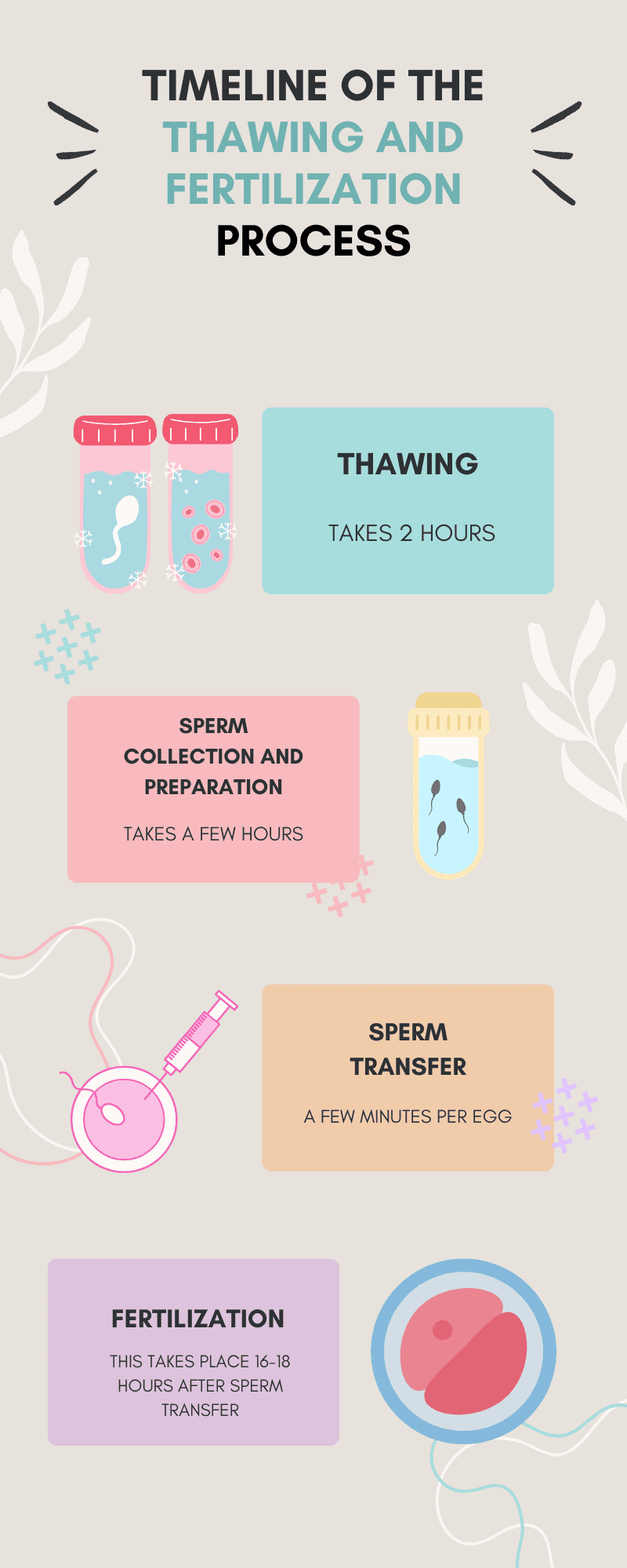The World Health Organization (WHO) estimates that 1 in 6 adults face infertility challenges. So, starting your path to parenthood with egg freezing is a hope-filled journey.
At the same time, you’re part of a growing trend. The global egg-freezing market has a whopping USD 3.9 billion valuation in 2022. This will likely grow to USD 13.5 billion by 2030.
Entrusting your future family dreams to frozen eggs is a big step. But what happens next? This blog is your guide to understanding what comes after egg freezing. Dive into learn: Table of Contents
Understanding the Thawing and Fertilization Process
Thawing refers to the process of warming up frozen eggs. Here’s a breakdown of the process:
- First, doctors put the eggs in a container at 20ºC for 30 seconds.
- Then, they soak it in warmer water for 40 seconds.
- Next, the eggs sit in two solutions to help them adjust to the temperature change.
- After that, they go into a unique saltwater mix.
- Finally, experts place them in a fluid like the one in human bodies. This keeps them warm until it’s time to add sperm.
While this process is taking place, doctors also get the sperm ready. They use a process called “sperm washing” to pick out the best ones. Then, they inject the sperm into the warmed egg.
After putting the sperm into the eggs, they wait for fertilization. They know it’s working if they see two tiny nuclei inside each egg.
The Timeline of Thawing and Fertilization: How Long Does the Thawing and Fertilization Process Take?
The Journey After Fertilization
Once the eggs and sperm fuse (forming an embryo), they go through a process to help them grow into babies:
- In three days, the embryos grow to have 6-8 cells.
- By the fifth or sixth day, the healthiest ones become blastocysts. This is a big ball of cells that’s dividing fast.
- At this stage, doctors look at the embryos to choose the best ones. They base their decision on how many cells there are, how they look, and if they have the correct number of chromosomes. Sometimes, they may do extra tests to ensure the embryos are healthy and don’t have any genetic issues.
- Then, the doctor puts the chosen embryo into your uterus. They use a thin tube for this. Don’t worry, it doesn’t hurt. You also won’t need anaesthesia.
- After this, you wait for two weeks and then take a pregnancy test to see if the process worked.
What is the Success Rate of Thawing and Fertilizing Frozen Eggs?
In one study, about 74 out of 100 eggs survived after the thawing process. 67% of these fuse with sperm. But, these numbers can vary based on:
- Your age when you freeze eggs. If you freeze your eggs when you’re younger, they’re usually better quality. This boosts success rates.
- The egg freezing techniques. An effective way to freeze eggs is vitrification. It cools the eggs fast, which helps them survive better during thawing.
- The quality of your frozen eggs. Higher-quality eggs lead to a higher success rate.
- Sperm quality. Healthy sperm that move well boost fertilization success chances.
- The quality of the embryo. Better-quality embryos are more likely to lead to a live birth.
What is the Difference Between Thawing and Fertilizing Frozen Eggs and Using Fresh Eggs for IVF?
| Using frozen eggs | Using fresh eggs | |
| IVF success rate | 27% | 58% |
| Flexibility | Offers flexibility in timing as eggs can be stored for years.
This is beneficial for those who want to preserve fertility. |
Requires synchronization with menstrual cycle.
Thus, less convenient as the process must be completed in one cycle. |
| Cost | Lower cost per cycle. | Higher cost per cycle |
| Emotional considerations | Sense of security for future planning. | Involves immediate decision-making which can be stressful |
What are the Risks and Side Effects of Thawing and Fertilizing Frozen Eggs?
When using frozen eggs for having a baby, it’s vital to be aware of some risks. These include:
- Eggs might not survive the thawing process. Sometimes, eggs don’t handle the freeze and thawing process well. This could lead to fertilization failure.
- Emotional stress. The uncertainty of the outcome can be stressful. In fact, in a study of 842 women undergoing IVF, about 21% experienced anxiety or depression.
- Risk of multiple pregnancies. A study showed that the risk of multiple pregnancies increases by 30% with IVF. This can be risky for the mother and the baby. For example, the mother may develop conditions like pre-eclampsia and gestational diabetes. Pre-eclampsia is six times more common with IVF than spontaneous pregnancies. Likewise, gestational diabetes occurs in 31.2% of IVF pregnancies. This number is 25.8% in normal pregnancies.
What are Your Options if the Eggs do not Thaw or Fertilize Well?
It can be stressful when thawing and fertilizing frozen eggs doesn’t work. Fortunately, you still have options. For example, you can:
- Use more frozen eggs.
- Use fresh eggs. Sometimes, starting fresh with new eggs can help.
- Try donor eggs or embryos.
- Try surrogacy. This is where someone else carries the baby for you.
- Re-evaluate your plan. Your doctor can suggest different techniques or treatments.
Remember, you can still have a family. Your doctor can help you find the best option for you.
Preparing for Thawing and Fertilization: How to Prepare for the Thawing and Fertilization Process?
The thawing and fertilization process is physically and emotionally demanding. It also comes with a financial toll. So preparation is vital.
To prepare physically:
- Eat well. A Mediterranean diet rich in fruits and whole grains can lead to higher birth rates.
- Exercise in moderation. Staying active helps, but don’t overdo it. In one study, exercising for more than 4 hours a week lowered the chances of having a baby.
- Avoid smoking. Smoking makes the outer layer of your eggs harder. This makes it more challenging for sperm to penetrate it.
Likewise, to get ready emotionally:
- Learn to manage stress. People during IVF feel more stressed and anxious than usual. Techniques such as yoga can help reduce these feelings. For example, just six weeks of yoga made a big difference in one study.
- Develop a support network. Talk to your partner about what’s going on. If you don’t have a partner, joining a support group can be helpful.
Lastly, financial planning is crucial. Plan for the costs involved in the process. Also, think about how you’ll manage your time for clinic visits and recovery.
What Should You Ask Your Doctor about the Thawing and Fertilization Process?
When you meet with your doctor about using your frozen eggs, it’s essential to ask the right questions. This helps you feel ready for the journey ahead. To achieve this, you can ask your doctor about:
- Clinic success rates.
- Risks and side effects.
- The techniques they use.
- Necessary lifestyle changes.
- Costs.
- The next steps if the process doesn’t work.
The Costs Involved in the Thawing and Fertilization Process
| Cost in Singapore dollar (SGD) | Cost in USD | |
| Initial consultation | 150 | 110 |
| Thawing | 500 | 365 |
| IVF | 10,000 | 7300 |
| Embryo transfer | 3000 | 2190 |
| Medications | 2000 | 1460 |
| Lab fees | 1500 | 1095 |
| Additional procedures (if needed) | 2000 | 1460 |
Takeaway
Egg freezing, thawing, and fertilization are not just medical procedures. They are a journey of hope to potential future parenthood. But remember, it requires patience, understanding, and emotional readiness.
Your journey doesn’t end with the freezing of your eggs. Your next steps may involve thawing and fertilization or considering other options. We’ve broken down what this means for you in detail.
So, if you have any other questions or are ready to take the next step, contact us today.
Anna Haotanto is the Founder of Zora Health and a passionate advocate for women’s empowerment. Anna’s personal experiences with egg-freezing, PCOS and the challenges of fertility have fueled her mission to provide high-quality information, financing, and support to help women and couples navigate their fertility journeys with confidence. She is also recognised for her achievements in finance, entrepreneurship, and women’s empowerment, and has been featured in various media outlets. You can also follow her on Linkedin or Instagram.






